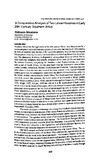Please use this identifier to cite or link to this item:
http://hdl.handle.net/10311/893| Title: | A comparative analysis of two labour reserves in early 20th century Southern Africa |
| Authors: | Ntsabane, T. |
| Keywords: | Labour Reserves |
| Issue Date: | 2003 |
| Publisher: | Pula: Botswana Journal of African Studies |
| Citation: | Ntsabane, T. (2003) A comparative analysis of two labour reserves in early 20th century Southern Africa, Pula: Botswana Journal of African Studies, Vol. 17, No. 2, pp.105-114 |
| Abstract: | Southern Africa has through much of its 20th century history been characterised by a centre~periphery regional economic system. At the centre has been South Africa(minus its African reserves) and the rest of the region the periphery. Key has been the migrant labour system whereby the centre has been able to extract cheap labour from its periphery. The cheapness, however, is disputed by among others Burawoy (1976). The labour- supplying periphery was actually composed of two tiers. On the one hand were the African Reserves, comprising the Transkei, Ciskei, Bophuthatswana, etc., politically a part of South Africa. On the other hand were the independent states of Botswana, Lesotho, Swaziland, Malawi, Mozambique and Zimbabwe |
| URI: | http://hdl.handle.net/10311/893 |
| Appears in Collections: | Research articles (Dept of Sociology) |
Files in This Item:
| File | Description | Size | Format | |
|---|---|---|---|---|
| Ntsabane_PBJAS_2003.pdf | 746.79 kB | Adobe PDF |  View/Open |
Items in DSpace are protected by copyright, with all rights reserved, unless otherwise indicated.
